At the completion of the lost wax process, Obara turns his attention to both the final assembly and the finishing process.
Depending on the size and complexity of the work, several castings may need to be welded and/or silver soldered together.
Chasing—removal of welds, gates and sprues—can take days, depending on the size and detail. Obara uses wheel grinders, Dremel tools, chisels and files to remove excess metal. Often, areas must be sand blasted or glass beaded to determine what work remains. When all the sculpture’s seams are invisible, the piece is ready for the next step.
Adding more detail is a painstaking process. As needed, Obara will even craft his own chisels to make desired patterns.
Obara applies overlays of traditional chemicals — never polychrome, i.e. oil paint — at various heat temperatures to attain different colors. For example, he uses copper sulfate for greens and ferric nitrate for browns. It has taken him years of experimentation to master the chemical compounds needed to formulate his unique colors.
To apply a proper patina, says Obara, “the sculptor must be part scientist, part sorcerer and part magician.” Chemical overlays treated at various temperatures result in a limited palette. By associating similar colors, the sculptor can lead the viewer’s eye to perceive a color that is really only implied. When using a torch ranging from 1500-2000° F, it’s easy to scorch or burn the patina. The only way to fix such a problem is to sand blast the surface and start over.
Waxing the bronze is the final step. Obara likes to wax the bronze when it is still warm because the wax will penetrate the surface and set the patina. Some clients, however, prefer to skip the waxing process for an outdoor piece and allow nature to take over and eventually change the surface to a natural brownish-green patina called verdigris. The length of time depends on where the sculpture is installed. In polluted city air the bronze will turn shades of green or brown to black. In the country, where the air is cleaner, it may never change or do so very slowly. For large outdoor sculptures, Obara first uses government-approved sealers then applies the wax to produce a luster. As a finishing touch, Obara gently rubs the bronze with an emery cloth to accent highlights such as the pupils of the eyes or other prominent features.
The final step is documenting the provenance for the bronze.
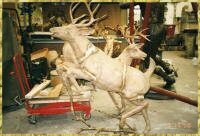
Deer pieces welded together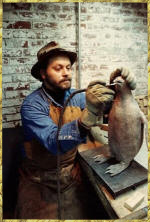
Chasing the Emperor penguin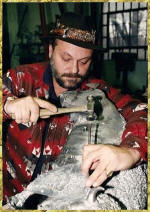
Detailing the casting of the sterling bison

Adding patina to the giraffe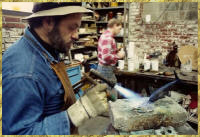
Applying patina to the white marlin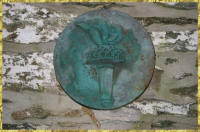
Verdigris
